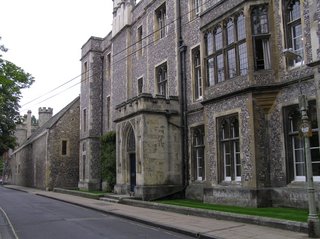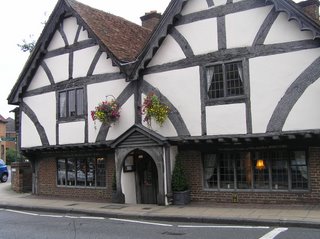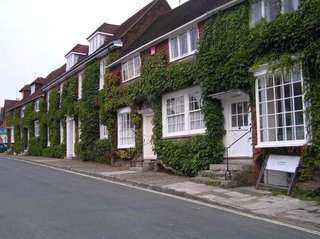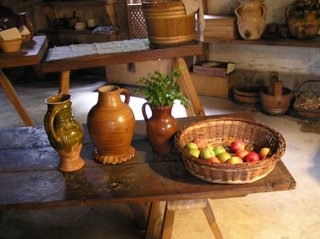
At last I'm getting to the final part of my visit to Sussex and, as I'm fighting off a migraine, this is likely to be fairly short and sweet but I want to get it done before I go again next week for another course, this time on preserving food in Tudor times. Fortunately I kept a journal of sorts otherwise I'd be struggling to remember what happened by now!. The photographs will be mostly of the Weald and Downland Museum as the ones I took inside Winkhurst kitchen of the breadmaking etc turned out very badly, there is no electric light, only the light from the door and tiny windows plus candles and I'm not a good enough photographer yet to make the right adjustments.

There were eight of us doing the Tudor Bakehouse course, four men and four women. It's very unusual to get an even balance like that, usually there are only one or two men at most. The men were very useful as they did all the playing with fire to get the oven heated up and had a thoroughly good time doing it. Did their masculine egos no end of good as we ladies looked on admiringly! In the morning we made just plain household bread using flour as it would have come from the miller ie wholemeal - really wholemeal which makes a very solid and filling loaf. It's possible to make finer flour by sieving which removes a good portion of the bran but still leaves what we would consider a wholemeal flour and then it's possible to boult it which is incredibly hard work.
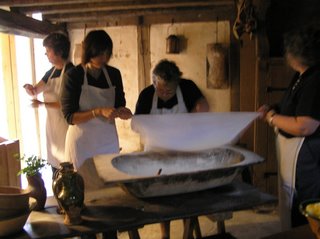 The wholemeal flour is rubbed through a muslin cloth using a large wooden ladle and it takes forever to produce quite a small amount of fine white flour. As you can imagine this sort of flour was used only on special occasions and in wealthy households. The photo isn't very clear and was taken on the second day when we were all women, only two of us did both days.
The wholemeal flour is rubbed through a muslin cloth using a large wooden ladle and it takes forever to produce quite a small amount of fine white flour. As you can imagine this sort of flour was used only on special occasions and in wealthy households. The photo isn't very clear and was taken on the second day when we were all women, only two of us did both days.We made bread with two doughs, one left overnight to rise in a cool atmosphere and the other made that morning and using the traditional warm rise.

The overnight rise actually made much nicer bread and I'm going to give that a try in the near future.
 While the dough was rising the oven was fired up, it took 5 large bundles of sticks to heat it to sufficient temperature to bake bread.
While the dough was rising the oven was fired up, it took 5 large bundles of sticks to heat it to sufficient temperature to bake bread.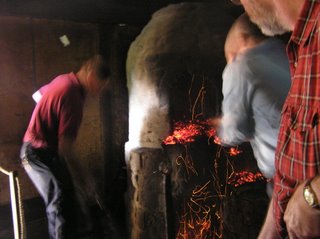 When you judge it is hot enough, the fire embers are raked out and the inside is given a quick once over with a damp bundle of rags on a stick and the loaves are loaded in with a paddle. The wooden oven door, which has been soaking in water is then quickly put in place and sealed with a mixture of flour and water mixed to a sort of sticky pastry consistency - my job for this particular time and as I always make my pastry by hand rather than machine I was able to judge the consistency pretty well.
When you judge it is hot enough, the fire embers are raked out and the inside is given a quick once over with a damp bundle of rags on a stick and the loaves are loaded in with a paddle. The wooden oven door, which has been soaking in water is then quickly put in place and sealed with a mixture of flour and water mixed to a sort of sticky pastry consistency - my job for this particular time and as I always make my pastry by hand rather than machine I was able to judge the consistency pretty well. The term the 'upper crust' comes from this process as, of course, the bottom of the loaves tends to be rather black fom the residue of the ashes, consequently the bread was sliced horizontally and the wealthy family members got the nice clean upper crust and the servants and also rans got the grotty bits off the bottom - so now you know!
The term the 'upper crust' comes from this process as, of course, the bottom of the loaves tends to be rather black fom the residue of the ashes, consequently the bread was sliced horizontally and the wealthy family members got the nice clean upper crust and the servants and also rans got the grotty bits off the bottom - so now you know!
By the time the bread came out of the oven it was time for lunch which we had sitting in the warm sunshine by the lake. Then it was back to the kitchen to prepare dough to make fancy breads, we divided into three groups and one lot made a panettone type dough, another did a herby bread and my group made something similar to Scottish Black Bun - a heavily fruited and spiced dough enclosed in a plain dough case (Black Bun actually has pastry as the outer case). The oven was fired again - more good times for the boys - and the various breads were baked. Of all of them I liked the herb one best, that group had used a lot of fennel among their herbs and as I love the taste of aniseed it really appealed to me. Then came the really hard work as we had to clean all the utensils and scrub the wooden tables using salt as a scourer and a disinfectant.
The next day we made all kinds of pastry and pies. We split into groups again and my partner and I made a bean tart using butter beans as the main ingredient. It neither sounded nor looked particularly appetizing but those who tasted it said it was actually very nice. Other things made were a jam tart, apple dumplings and custard tarts.
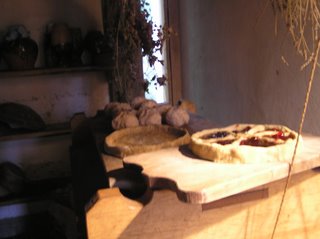 As on the previous day the oven was fired twice, once in the morning and once in the afternoon. In the afternoon we all made hot water crust pastry which is something I like to eat but have never tried to make before. It was surprisingly easy and I shall certainly have a go at the filling I concocted for mine using apples, raisins, brown sugar and cinnamon topped off with walnuts of butter. Others made savoury fillings using fish and herbs or cheese and onions.
As on the previous day the oven was fired twice, once in the morning and once in the afternoon. In the afternoon we all made hot water crust pastry which is something I like to eat but have never tried to make before. It was surprisingly easy and I shall certainly have a go at the filling I concocted for mine using apples, raisins, brown sugar and cinnamon topped off with walnuts of butter. Others made savoury fillings using fish and herbs or cheese and onions. Unfortunately the course finished before these had baked so we never got to try the results of our labours. I just know that apple-y/cinnamon thing of mine was good though. It will all have been eaten the following day by volunteers and visitors to the museum.
Unfortunately the course finished before these had baked so we never got to try the results of our labours. I just know that apple-y/cinnamon thing of mine was good though. It will all have been eaten the following day by volunteers and visitors to the museum.
As I was leaving I took these photographs of Romany caravans and the traditional piebald horses as well as the colourful miniature Romany caravan below , both were part of the preparation for a weekend about Romany people and their way of life. I wish I could have seen that, it must have been fascinating.

OK Bloggger is at it again, it's says it has uploaded photos but they are not appearing. It's been like this since last night so I'm going to publish this now and keep trying to edit the photos in during the day. I'm going to be at home baking and writing letters so I can do it in between things - I hope!
Success! Thanks to those who reminded me about Mozilla Firefox, it's worked the oracle. The photos have all turned out to be of the course after all so I'll put up some of the rest of the Museum tomorrow.







